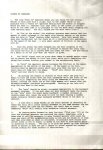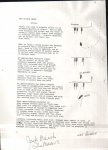Squeaky
New member
Good morning
I have used this system for a number of years but have not seen others using it so am posting this in hopes that others will find it useful.
The Caique Swing:
A lot of yachtsmen have a lot of trouble mooring stern to quays claiming that their yacht does not perform well in reverse gear. Mine is no different as it almost unsteerable until it is moving at several knots in reverse gear and I have to make sure that it is steerable before approaching any quayside. This is achievable if mooring in a marina because there is always sufficient room to achieve steerage prior to reversing down an alley between two pontoons. It is usually possible in a harbour however once you have achieved this one has to make sure that the bow is in a position so that the anchor will drop between the neighbouring chains and not over one or the other.
An achoring/mooring technique that I first observed in Hydra twenty plus years ago seemed to solve so many problems that I decided to practice it and see if I could master it for myself. After a bit of practice using vacant quaysides to give me lots of room for errors or misjudgement I quickly became familiar with the various forces at work which had to be taken into consideration. Having used it for many years I have avoided a lot of the common errors that yachtsmen make when mooring stern to a quay including not dropping my anchor over other anchor chains and ensuring that the anchor is dug in and that the chain is straight between the anchor and stemhead. I usually found if I didn’t put any strain on the anchor prior to trying to put tension on the chain after securing the stern that the anchor would simply skip along the bottom and end up below the stem head – the Caigue Swing ensures that this does not happen.
On the question of not dropping my anchor over others I eventually realized it is almost impossible to stand at the helm facing the spot you want to use on the quay and then turn 180 degrees and accurately evaluate if your anchor will drop between the neighbouring chains to port and starboard or not because it is difficult to turn and look 180 degrees from the direct you were originally looking therefore the yacht might be lying at an angle to the direction you want to move meaning that the bow might well be directly over someone else’s chain. Using the Caigue Swing method it is obvious as you see everything in one view i.e the bow, the spot on the quay and the neighbouring chains and it is simple to line up so that your bow in positioned between the neighbouring chains. Once the anchor has been dropped and laid on the bottom the act of snubbing the anchor in order to begin the swinging motion will ensure that the anchor is dug in as it must be in order to stop the forward motion of your yacht.
The main objection I receive is the claim that the chain will damage the hull or anti-foul when you begin the turn but this is not true as by turning the bow off line a metre or two ensures that the chain will straighten out between the anchor and stemhead and not touch the hull. It can only touch the hull if you have not turned the bow enough to port or starboard.
The following was prepared in the early 90s when an Italian skipper approached and began questioning me after I arrived in Skiathos. As I had the latest modern equipment on board i.e. a portable typewriter, I amused myself by preparing the following for him which I think contains most of the important points. It was prepared with a view to having crew available but I find it works even better when solo with a long wander lead on the anchor control. I am always happy to provide any further explanation or discussion if there is not sufficient details or anyone needs more information.


I have used this system for a number of years but have not seen others using it so am posting this in hopes that others will find it useful.
The Caique Swing:
A lot of yachtsmen have a lot of trouble mooring stern to quays claiming that their yacht does not perform well in reverse gear. Mine is no different as it almost unsteerable until it is moving at several knots in reverse gear and I have to make sure that it is steerable before approaching any quayside. This is achievable if mooring in a marina because there is always sufficient room to achieve steerage prior to reversing down an alley between two pontoons. It is usually possible in a harbour however once you have achieved this one has to make sure that the bow is in a position so that the anchor will drop between the neighbouring chains and not over one or the other.
An achoring/mooring technique that I first observed in Hydra twenty plus years ago seemed to solve so many problems that I decided to practice it and see if I could master it for myself. After a bit of practice using vacant quaysides to give me lots of room for errors or misjudgement I quickly became familiar with the various forces at work which had to be taken into consideration. Having used it for many years I have avoided a lot of the common errors that yachtsmen make when mooring stern to a quay including not dropping my anchor over other anchor chains and ensuring that the anchor is dug in and that the chain is straight between the anchor and stemhead. I usually found if I didn’t put any strain on the anchor prior to trying to put tension on the chain after securing the stern that the anchor would simply skip along the bottom and end up below the stem head – the Caigue Swing ensures that this does not happen.
On the question of not dropping my anchor over others I eventually realized it is almost impossible to stand at the helm facing the spot you want to use on the quay and then turn 180 degrees and accurately evaluate if your anchor will drop between the neighbouring chains to port and starboard or not because it is difficult to turn and look 180 degrees from the direct you were originally looking therefore the yacht might be lying at an angle to the direction you want to move meaning that the bow might well be directly over someone else’s chain. Using the Caigue Swing method it is obvious as you see everything in one view i.e the bow, the spot on the quay and the neighbouring chains and it is simple to line up so that your bow in positioned between the neighbouring chains. Once the anchor has been dropped and laid on the bottom the act of snubbing the anchor in order to begin the swinging motion will ensure that the anchor is dug in as it must be in order to stop the forward motion of your yacht.
The main objection I receive is the claim that the chain will damage the hull or anti-foul when you begin the turn but this is not true as by turning the bow off line a metre or two ensures that the chain will straighten out between the anchor and stemhead and not touch the hull. It can only touch the hull if you have not turned the bow enough to port or starboard.
The following was prepared in the early 90s when an Italian skipper approached and began questioning me after I arrived in Skiathos. As I had the latest modern equipment on board i.e. a portable typewriter, I amused myself by preparing the following for him which I think contains most of the important points. It was prepared with a view to having crew available but I find it works even better when solo with a long wander lead on the anchor control. I am always happy to provide any further explanation or discussion if there is not sufficient details or anyone needs more information.


